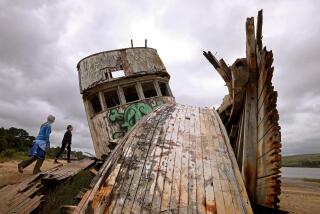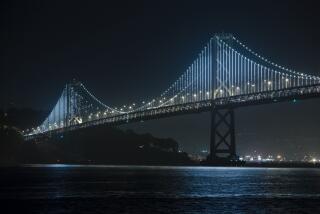Darkened Lighthouse Has Brighter Days Ahead
ST. GEORGE REEF, Calif. — First, it was fog. Volunteers who were trying to restore a 110-year-old lighthouse by carrying a 5-ton lantern room by helicopter over the Pacific Ocean waited it out.
Then came the rain. The plan to move the dome was delayed again, and volunteers wondered when they would have another chance.
But the next morning, Guy Towers and the rest of his restoration team saw the rain ease up. They made their move, and soon the helicopter hovered in the drizzle, picked up the lantern room and carried it to St. George Reef Lighthouse while about 100 spectators huddled in the Crescent City harbor on the far northwestern coast of California.
For fans of a landmark that has seen plenty of disasters, it was what they hoped was more than a break in the weather. They hoped the lantern’s return April 13 would signal the revival of a lighthouse that once steered seafarers away from the area’s ship-eating reef.
If successful, the restoration by the St. George Reef Lighthouse Preservation Society could create a tourist attraction in a forgotten corner of California whose logging and fishing industries have long faded.
Sitting six miles off the coast, the 150-foot lighthouse cost $704,000 to build in 1892. Named after the dragon-slaying St. George, it sits surrounded by the “dragon rocks” that tore the bottom from the steamer Brother Jonathan in 1865, killing at least 145 passengers and crew.
The lighthouse destined to tame the rocks was the most expensive the federal government ever built. The deadliest too.
Between 1892 and 1975, when the lighthouse was replaced by a buoy, five lighthouse workers died. That included three U.S. Coast Guardsmen killed in 1951 when their boat capsized as they left the rock.
Replacing the 16-sided, 12-foot-high lighthouse dome has bedeviled Towers and the other volunteers. Weather delays kept them from making the helicopter trip; no one wanted to risk $60,000 for the cost of the dome and the helicopter for a failure.
When it’s done, the society will have turned the St. George Reef Lighthouse into the only one of three offshore lighthouses in the world that will be open to the public. There, visitors will learn more about its turbulent history.
Crescent City’s other lighthouse, the nearby Battery Point Lighthouse, still lights the harbor from shore and also serves as a museum.
The only way to the St. George Reef Lighthouse now is by a six-minute helicopter ride low over the ocean.
The iron railings that once surrounded the deck of the lighthouse have rusted into the sea, leaving an ideal landing pad for the helicopter.
There are seven levels from the basement, where the coal-fired generators ran the lighthouse, to the lantern at the top that housed the rotating lens.
Inside, the old paint peels in large patches from the damp ceilings and cement walls. Much of the paint was lead-based, so workers must be careful while removing it, volunteer Terry McNamara said.
The upper deck, just below the lantern room, is more than 130 feet above the rocks, encircled by bands of rust that 110 years ago were scrolling cast-iron railings.
Lights are run off a generator. When it sputters, Towers or one of the volunteers races down the 90 narrow, spiraling stone steps as the lights flicker to refill the fuel. If the lights go out, the steep stairwell goes nearly black.
A retired social worker, Towers first became interested in lighthouses in the early 1980s, when he discovered the Punta Gorda lighthouse in Humboldt County.
He embarked on a two-decade obsession, in which he once spent three years cataloging the world’s lighthouses.
In 1986, after he had moved to Crescent City, he learned that the government planned to sell the lighthouse as scrap. Towers and several friends formed the nonprofit preservation society and then spent 10 years getting government approvals to take jurisdiction over the lighthouse.
He worked closely with Bob Bolen, a retired airline mechanic who was instrumental in removing and transporting the lighthouse’s giant Fresnel lens in 1983. The 18-foot rotating lens now sits in the Del Norte County Museum.
Bolen, now wheelchair-bound, paid the $24,000 the society needed to finish the restoration work on the dome and hire a helicopter to bring it back to the lighthouse.
For that, he got the best view of the lantern room’s return--the front seat of the chase helicopter trailing the cargo chopper.
It was the second attempt to transport the dome in two years.
In April 2000, a donated helicopter lifted the lantern room from the lighthouse and carried it to shore. But as it approached land, the helicopter dipped too low, dragging the iron and glass room along the beach in Crescent City harbor.
“It was a crumpled mess,” said Alice Towers, Guy’s wife.
But that disaster turned into a blessing, Towers said, as the publicity led to more donations. Also, the room had broken in the right places.
Its top survived, and the rest of the room was rebuilt with stainless steel, not cast iron, and polycarbonate, not glass. That saved about 5,000 pounds, Towers said, although it still weighs a hefty 10,000 pounds.
As the helicopter lifted the lantern room for its second flight, Towers and half a dozen volunteers waited on the rock at the top of the lighthouse for the big cargo chopper to hover, then lower the dome. Cables trailed from the room that would be threaded through holes in the ledge to guide it to its proper position.
Towers grabbed the first line and wrapped it around his arm. The helicopter rose, taking Towers with it.
“It was like I was ringing a bell, riding the bell up and down,” he said.
The 32 bolt holes lined up “perfectly,” he said. “The sweetest sound I’ve ever heard was when that lantern room set and it made that ‘clunk.’ ”
After the lift, Bolen was all smiles as he was helped out of the helicopter.
He and other volunteers will start raising money to replace the rusting railings in time for a planned opening this fall.
Wildlife officials prohibit travel to the lighthouse between June 15 and Oct. 15, when sea lions are mating, so tours will be offered only in the fall and spring. Eventually, Towers hopes to have a helicopter stationed in Crescent City to ferry visitors on day trips.
The time and money to revive the lighthouse will be worth it, Bolen said.
“To me, they’re monuments to our forefathers who came to our country and to the men who didn’t make it,” Bolen said. “They didn’t make it because they didn’t have lighthouses.”
More to Read
Sign up for The Wild
We’ll help you find the best places to hike, bike and run, as well as the perfect silent spots for meditation and yoga.
You may occasionally receive promotional content from the Los Angeles Times.






